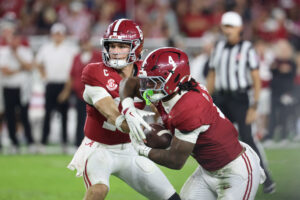Richard Hendrix once reached the pinnacle of the basketball world at Alabama and in the professional ranks. Now he is making his hometown even more proud with his new venture.
Richard Hendrix was adjusting his tie for a photoshoot when a voice rang out across the courthouse square of his hometown of Athens, Alabama.
“Looking good Richard!” said a woman who recognized the hometown hero on sight.

Hendrix shaded his eyes and scanned the sidewalk across the street. Then his face broke into a huge smile as he recognized the familiar face.
“It’s great to see you! How are you doing?” he responded.
As the photoshoot continued in several locations around town, the reaction was almost universally the same. And it wasn’t just because the 6-foot-8 Hendrix was sharply attired in suit and tie on a sweltering hot day. It wasn’t just because he is the Superman of Athens High School basketball, a Limestone County legend, and one of the best to don the crimson-and-white of the Alabama Crimson Tide. It was equally as much because he is the son of Venard Hendrix, a 40-plus year educator and Richard’s basketball coach at Athens High, and Valarie Hendrix, a long-time seventh grade science teacher, who also taught her son in middle school.
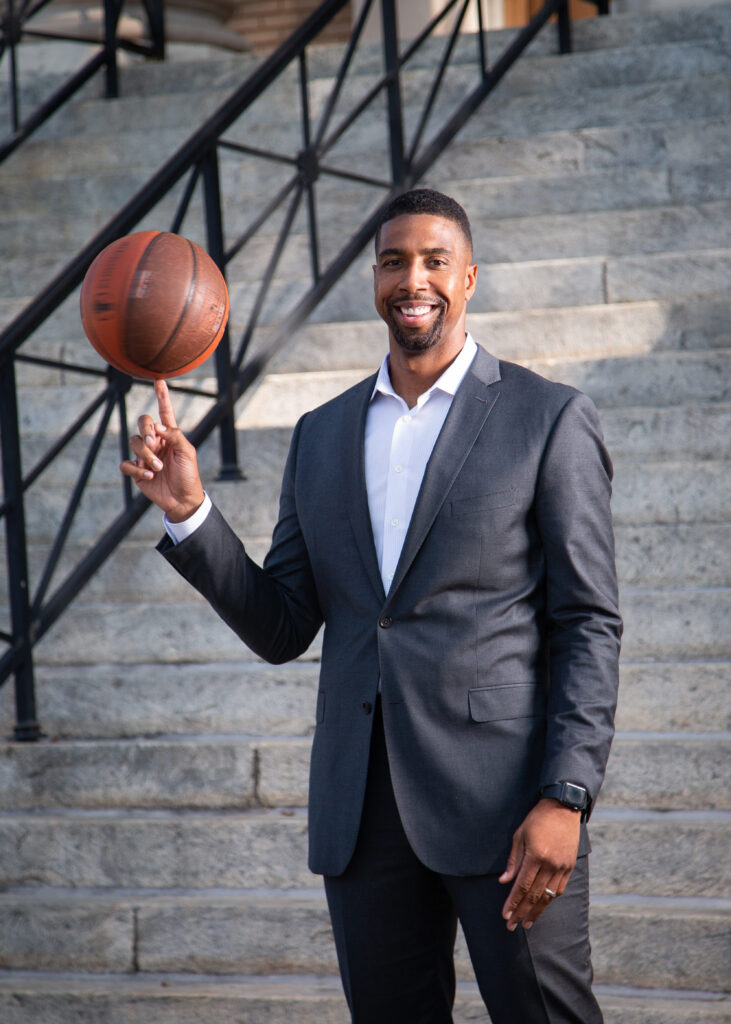
By the time the photoshoot was over, Hendrix had shaken more hands, posed for more pictures, and spread more good cheer than any politician campaigning for public office could have ever hoped to spread. In short, people love him because of what he and his family mean to Athens and because of what Athens means to them.
“That’s pretty typical Athens,” says Hendrix, who now makes Nashville his home. “Anytime I come here I’m going to always see somebody I know, and they are always going to want to know how I’m doing and how my folks are doing. Athens will always be home.”
It was in Athens, a town of 25,000 residents resting 14 miles from the Tennessee state line, that Hendrix burst onto the local sports scene as a seven-year-old Little Leaguer blasting towering homers out of the neighborhood park on Fifth Avenue. It was there that he emerged as a basketball force, earning first-team all-state honors as a ninth grader en route to becoming a four-year starter for the Golden Eagles and the “best basketball coach I ever had.” And it was there, in his senior year of 2004-05, that he became the most sought-after high school recruit in the country, one that all the college basketball elites desperately wanted, including the North Carolina Tar Heels and their Hall of Fame coach, Roy Williams.
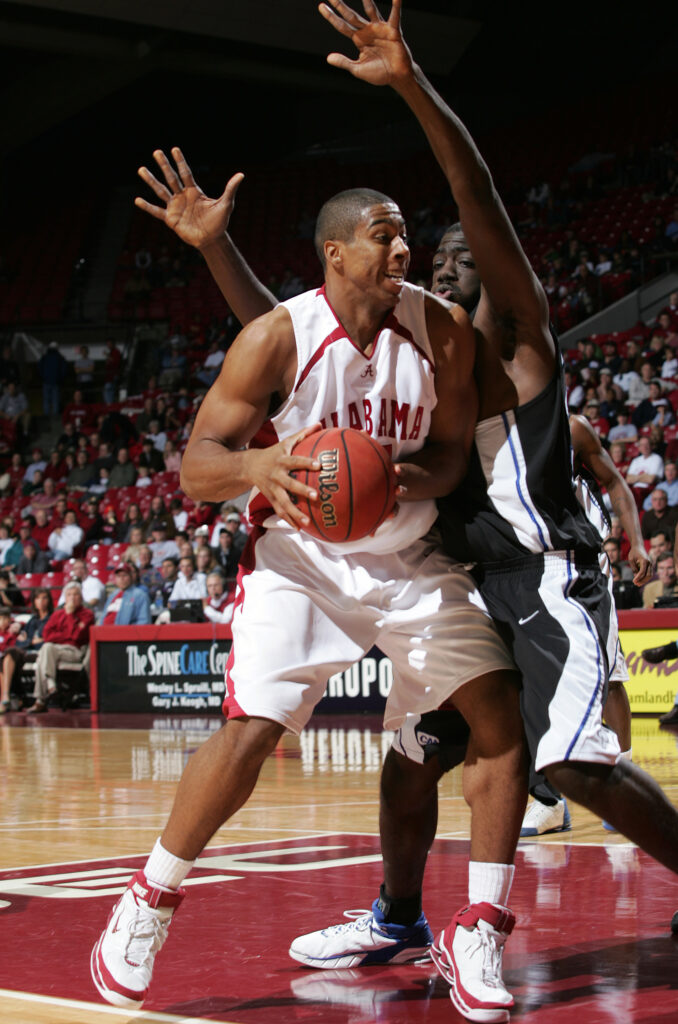
Photo By Jeff Hanson | Courtesy The Paul Bryant Museum
When National Signing Day came, however, the Class 5A Player of the Year, Alabama’s Mr. Basketball, and Parade and McDonald’s All-American stunned the college hoops world by signing with Alabama and coach Mark Gottfried. His decision was not made simply because he had grown up in a family of ‘Bama fans, including older sisters Lesley and Kristina, who graduated from Alabama in 2000 and 2003, respectively. It was also because Hendrix truly believed he could help take Crimson Tide hoops to greater heights.
“I’ve always felt like I could make a difference in anything I’ve tried to do in my life, and that’s why I chose Alabama,” said Hendrix, who will soon enter his third season calling Southeastern Conference (SEC) basketball games on ESPN’s SEC Network. “Programs like North Carolina were already basketball blue bloods as they call them, and I thought I could help Alabama reach that level, too.”
That wasn’t quite the case, as multiple injuries to key players and other circumstances made it a roller coaster of a ride for Hendrix at the Capstone. Playing with fellow standouts Ronald Steele, Jermareo Davidson, Chuck Davis and others, Bama went 55-41 in his three seasons: 18-13 in 2005-06, 20-12 in 2006-07 and 17-16 in 2007-08. In his first season, the Tide went to the second round of the NCAA Tournament, the next year it bowed out in the first round of the NIT Tourney, and in his final season, didn’t make the postseason at all.
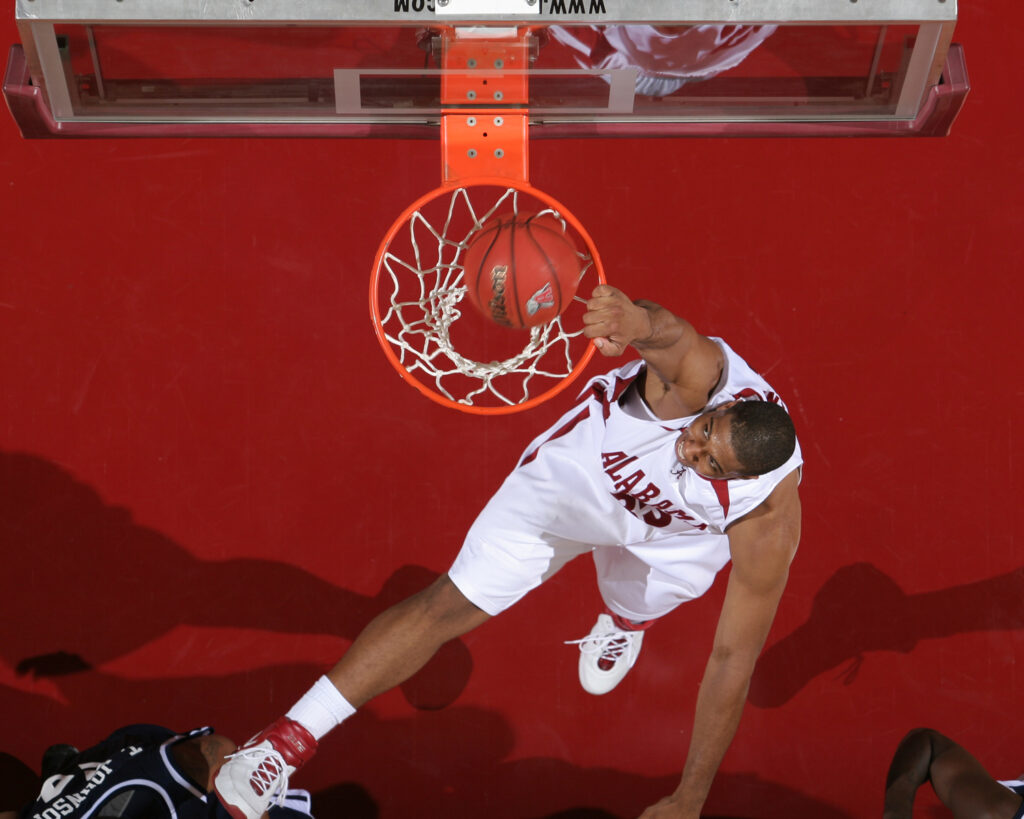
Photo by: Cory Johnson | Courtesy The Paul Bryant Museum
Individually, Hendrix made his mark, particularly on the glass, where he led the SEC in rebounding as a junior averaging 10.1 per game. In total, Hendrix played in 95 games for Alabama, averaging 14 points and 8.9 rebounds per game. He was a first-team SEC All-Freshman selection, earned All-SEC second-team honors as a sophomore, and was first-team All-SEC as a junior. He finished 24th on Alabama’s all-time scoring list with 1,327 points.
Gottfried recently recalled his experience with Hendrix this way: “Richard was a joy to coach. Probably one of the best ‘people’ I ever coached. He was a tremendous worker, and his motives were always pure. Wanted to win. Period.”
Despite the program not moving up the ladder as he had hoped, Hendrix does not second-guess his decision to choose crimson over Carolina blue. “I don’t have any regrets,” Hendrix said. “I made a lot of great friends at Alabama and a lot of connections that continue to help me to this day.”
With his degree in Public Relations already in hand after three years, Hendrix chose to forego his senior season and enter the NBA Draft, where he was a second-round selection of the Golden State Warriors, No. 49 overall. It was at this stage that Hendrix ran into adversity that would threaten to derail his athletic career.
After a preseason that included 12 points and 13 rebounds in his NBA debut, Hendrix made the Warriors’ final roster but spent the first several weeks on the inactive list before he was assigned to the NBA Developmental League in November 2008. On Dec. 18, 2008, the team released Hendrix, and just that quickly his NBA dream was gone.
Hendrix then joined the Dakota Wizards, another NBA D-League team, in 2009 and led the league in total rebounds.
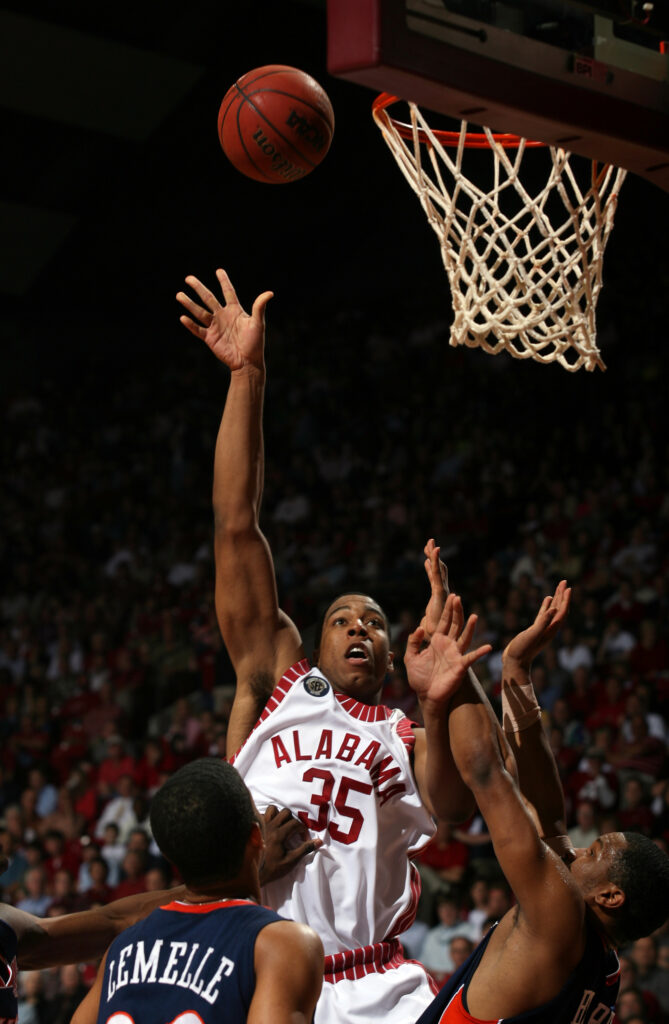
Photo By Kent Gidley | Courtesy The Paul Bryant Museum
But another call from the big show never came.
Ever resilient, he then embarked on a 13-year career in Europe and Japan that provided some of “the greatest memories of my life.” He played in the Spanish league, for teams in Israel, Italy, Turkey, and Japan, and spent almost three seasons playing for the Russian team Lokomotiv Kuban Krasnodar. All provided experiences he now draws on in his new role as a TV personality.
Fast forward to 2021 when some of Hendrix’ crimson connections opened the door for him to serve as color analyst for Alabama men’s and women’s TV games alongside Eli Gold and Roger Hoover for Crimson Tide Productions. In turn, that led to the call from ESPN to serve as both a sideline color commentator and studio analyst on the SEC Network. It was a natural transition.
“It was very smooth for me, and I love it,” Hendrix said. “I want people to be educated about the game of basketball, and I try to give that impression to the viewer. If something’s happening on the court that I think the viewer might not really understand, I try to articulate it in a way that helps them understand it.
“It’s great because it gives me the challenge of having to get up for the game without actually having to play the game.”
Gottfried, who is now retired from coaching and hosts a podcast based out of Newport Beach, Calif., called The Coach Mark Gottfried Show was excited to see one of his former players make a seamless move into the media world. “I have been so proud of Richard as he has transitioned successfully from playing into broadcasting,” Gottfried said.
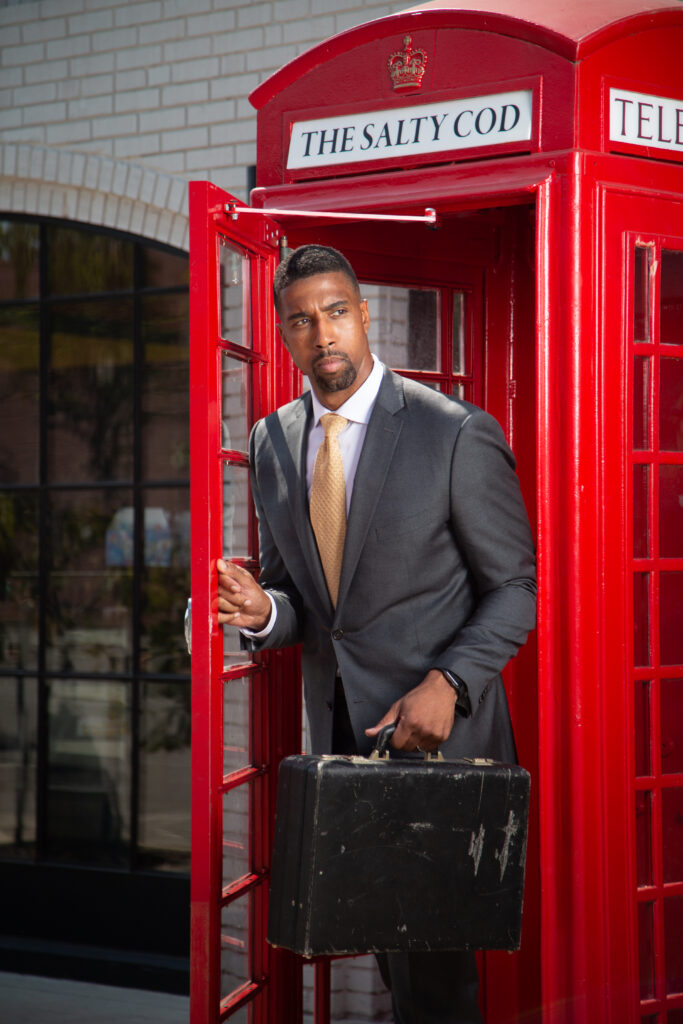
Courtside, Hendrix loves the athleticism he sees in today’s action. He loves the high level of play he sees game in and game out and the amount of pure talent in the SEC, particularly at Alabama, which went to its first Final Four last season. He loves being close to the game again and having his finger on the pulse, but that closeness has also allowed him to see a disturbing trend, one that hits close to home.
It’s the proliferation of “academies” and other manufactured settings designed to focus mainly on basketball that, in many cases, take kids away from family, friends and home in the process.
“You are robbing our youth of their childhood when you have those types of situations,” Hendrix said. “Kids nowadays are in too big of a rush to grow up, and I don’t think that’s the type of system we need. I tell kids any chance I get that the memories they make and the legacies they leave have an immense amount of value.”

Memories like playing for a coach and learning from a teacher who are now revered by thousands in the Athens community whose lives they touched over the years. “They had a huge impact,” Hendrix said of his parents. “It seems like every person you meet in Athens today was in class with one of my parents. The type of connections they made teaching people seem like they made a big difference in a lot of people’s lives as well as mine.”
Hendrix isn’t sure what his initial reaction would have been if someone had suggested that he leave Athens High School to play at a basketball factory. But he’s pretty sure his response would have most likely been, “thanks, but no thanks,” in great part because he couldn’t imagine leaving the teammates and friends he grew up playing with and bonding with in the process. Not only that, but he would have been leaving the people and the town that shaped him.
“There was a group of us who had a lot of success because we played together so much,” Hendrix said. “We were playing for Athens. We were playing for home.”
And if anyone knows anything about Richard Hendrix, no matter the arena he performs in, rest assured, he still is. TG
Photos by Al Blanton and courtesy The Paul Bryant Museum
Follow Talegate on Facebook and Instagram @talegatesports and make sure you subscribe to our YouTube channel for podcasts @talegate_sports!



